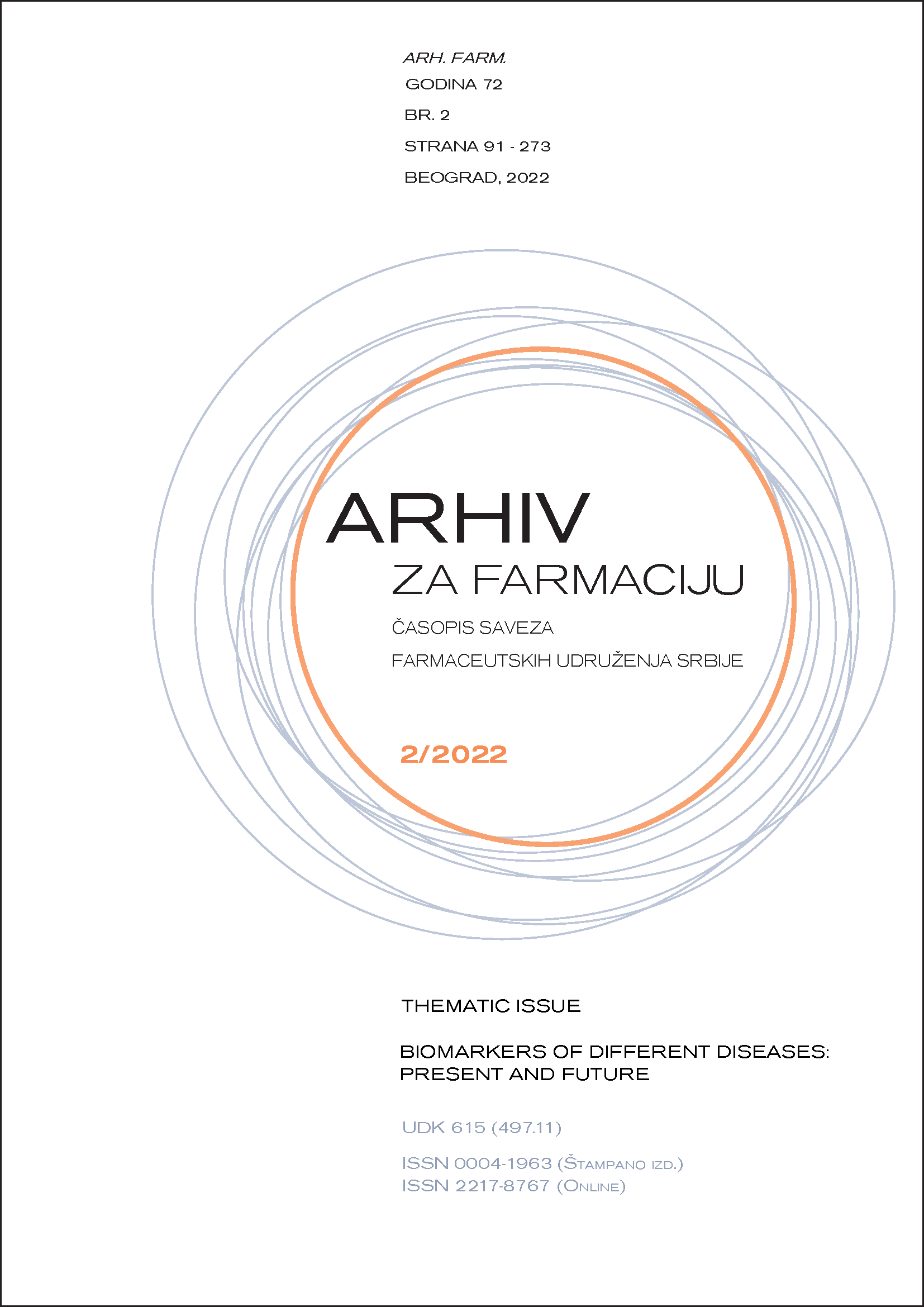Biomarkers of vitamin D status in healthy adults: associations with serum lipid parameters – a pilot study
Abstract
Vitamin D deficiency is among important healthcare challenges today. Traditionally, vitamin D status is assessed through determination of 25-hydroxy metabolite (25(OH)D), but novel data point to 24,25(OH)2D and 25(OH)D/24,25(OH)2D ratio (VDMR) as promising biomarkers. It is widely accepted that the biological role of vitamin D exceeds its well-known contribution to bone turnover. However, its effects on overall energy metabolism and lipid status alterations are not completely understood. In this study, we analyzed the relationship of vitamin D status assessed as concentrations of 25(OH)D3 and 24,25(OH)2D3 determined by liquid chromatography-tandem mass spectrometry, as well as VDMR with advanced lipid status parameters. Vitamin D status biomarkers, routine parameters of lipid status and size and distribution of lipoprotein subclasses were determined in 89 healthy adults (35 with adequate vitamin D status and 54 with vitamin D deficiency). Our results indicated a preponderance of pro-atherogenic small, dense LDL particles (sdLDL) in vitamin D deficient subjects. Both 25(OH)D and 24,25(OH)2D were associated with a relative proportion of sdLDL (β: -0.410; SE: 0.154; P=0.010; and β: -2.041; SE: 0.969; P=0.039, respectively). Positive correlation was found for VDMR and relative proportion of HDL 3a particles (ρ=0.251; P=0.024). VDMR value was decreased in subjects with vitamin D deficiency (P=0.001), thus implying its usefulness as a biomarker. A thorough investigation of novel vitamin D biomarkers and advanced lipid status parameters can be useful in the estimation of individual risk for the development of cardiometabolic alterations.
References
Holick MF. The vitamin D deficiency pandemic: Approaches for diagnosis, treatment and prevention. Rev Endocr Metab Disord. 2017;18(2):153-165
Lips P, Cashman KD, Lamberg-Allardt C, Bischoff-Ferrari HA, Obermayer-Pietsch B, Bianchi ML, et al. Current vitamin D status in European and Middle East countries and strategies to prevent vitamin D deficiency: a position statement of the European Calcified Tissue Society. Eur J Endocrinol. 2019;180(4):P23-P54.
Zhang R, Naughton DP. Vitamin D in health and disease: current perspectives. Nutr J. 2010;9:65.
Ellison DL, Moran HR. Vitamin D: Vitamin or Hormone? Nurs Clin North Am. 2021;56(1):47-57.
Vekic J, Zeljkovic A, Stefanovic A, Jelic-Ivanovic Z, Spasojevic-Kalimanovska V. Obesity and dyslipidemia. Metabolism. 2019;92:71-81.
Jorde R, Grimnes G. Vitamin D and metabolic health with special reference to the effect of vitamin D on serum lipids. Prog Lipid Res. 2011;50(4):303–312.
Ramasamy I. Update on the laboratory investigation of dyslipidemias. Clin Chim Acta. 2018;479:103-125.
Kaufmann M, Gallagher JC, Peacock M, Schlingmann KP, Konrad M, DeLuca HF, et al. Clinical utility of simultaneous quantitation of 25-hydroxyvitamin D and 24,25-dihydroxyvitamin D by LC-MS/MS involving derivatization with DMEQ-TAD. J Clin Endocrinol Metab. 2014;99(7):2567-74.
Tang JCY, Jackson S, Walsh NP, Greeves J, Fraser WD; Bioanalytical Facility team. The dynamic relationships between the active and catabolic vitamin D metabolites, their ratios, and associations with PTH. Sci Rep. 2019;9(1):6974.
Zeljkovic A, Spasojevic-Kalimanovska V, Vekic J, Jelic-Ivanovic Z, Topic A, Bogavac-Stanojevic N, et al. Does simultaneous determination of LDL and HDL particle size improve prediction of coronary artery disease risk? Clin Exp Med. 2008;8(2):109-16.
Vladimirov S, Zeljković A, Gojković T, Miljković M, Stefanović A, Zeljković D, et al. Associations of cholesterol and vitamin D metabolites with the risk for development of high grade colorectal cancer. J Med Biochem. 2020;39(3):318-327.
Dominguez LJ, Farruggia M, Veronese N, Barbagallo M. Vitamin D Sources, Metabolism, and Deficiency: Available Compounds and Guidelines for Its Treatment. Metabolites. 2021;11(4):255.
Tuckey RC, Cheng CYS, Slominski AT. The serum vitamin D metabolome: What we know and what is still to discover. J Steroid Biochem Mol Biol. 2019;186:4-21.
Herrmann M, Farrell CL, Pusceddu I, Fabregat-Cabello N, Cavalier E. Assessment of vitamin D status - a changing landscape. Clin Chem Lab Med. 2017;55(1):3-26.
Toribio MJ, Priego-Capote F, Pérez-Gómez B, Fernández de Larrea-Baz N, Ruiz-Moreno E, Castelló A, et al. Factors Associated with Serum Vitamin D Metabolites and Vitamin D Metabolite Ratios in Premenopausal Women. Nutrients. 2021;13(11):3747.
Ginsberg C, Katz R, de Boer IH, Kestenbaum BR, Chonchol M, Shlipak MG, et al. The 24,25 to 25-hydroxyvitamin D ratio and fracture risk in older adults: The cardiovascular health study. Bone. 2018;107:124-130.
Istraživanje zdravlja stanovništva Srbije 2019. godine [Internet]. Institut za javno zdravlje “Dr Milan Jovanović Batut”; 2021. Cited: 2022, Feb 4. Available from: https://publikacije.stat.gov.rs/G2021/pdf/G20216003.pdf..
Carrelli A, Bucovsky M, Horst R, Cremers S, Zhang C, Bessler M, et al. Vitamin D Storage in Adipose Tissue of Obese and Normal Weight Women. J Bone Miner Res. 2017;32(2):237-242.
Drincic AT, Armas LA, Van Diest EE, Heaney RP. Volumetric dilution, rather than sequestration best explains the low vitamin D status of obesity. Obesity (Silver Spring). 2012;20(7):1444-8.
Ching S, Kashinkunti S, Niehaus MD, Zinser GM. Mammary adipocytes bioactivate 25-hydroxyvitamin D₃ and signal via vitamin D₃ receptor, modulating mammary epithelial cell growth. J Cell Biochem. 2011;112:3393–405.
Nimitphong H, Holick MF, Fried SK, Lee MJ. 25-hydroxyvitamin D₃ and 1,25-dihydroxyvitamin D₃ promote the differentiation of human subcutaneous preadipocytes. PLoS One. 2012;7:e52171.
Vitezova A, Voortman T, Zillikens MC, Jansen PW, Hofman A, Uitterlinden AG, et al. Bidirectional associations between circulating vitamin D and cholesterol levels: The Rotterdam Study. Maturitas. 2015;82(4):411-7.
Ertugrul DT, Yavuz B, Cil H, Ata N, Akin KO, Kucukazman M, et al. STATIN-D study: comparison of the influences of rosuvastatin and fluvastatin treatment on the levels of 25 hydroxyvitamin D. Cardiovasc Ther. 2011;29(2):146-52.
Chow EC, Magomedova L, Quach HP, Patel R, Durk MR, Fan J, et al. Vitamin D receptor activation down-regulates the small heterodimer partner and increases CYP7A1 to lower cholesterol. Gastroenterology. 2014;146(4):1048-59.
Zhou R, Guo Q, Xiao Y, Guo Q, Huang Y, Li C, et al. Endocrine role of bone in the regulation of energy metabolism. Bone Res. 2021 May 20;9(1):25.
Batacchi Z, Robinson-Cohen C, Hoofnagle AN, Isakova T, Kestenbaum B, Martin KJ, et al. Effects of Vitamin D2 Supplementation on Vitamin D3 Metabolism in Health and CKD. Clin J Am Soc Nephrol. 2017;12(9):1498-1506.

